
ROSSON CROW










Recently, I was scrolling social media when I came across an online quiz. It was titled, “Do You Live in a Bubble?”
Originally developed in 2012 by the political scientist Charles Murray and adapted by PBS in 2016, the quiz aims to determine just how insulated an individual is from the socioeconomic realities of most Americans. The 25 questions include: During the last year, have you ever purchased domestic mass-market beer to stock your own fridge? Have you ever lived for at least a year in an American community under 50,000 people that is not part of a metropolitan area and is not where you went to college? Have you ever held a job that caused something to hurt at the end of the day? (No, headaches don’t count, and neither does carpal tunnel syndrome.)
On a scale of 0 (the most insulated from working-class reality) to 100 (the least insulated), I scored a 24.
The bubble that surrounds each of us, regardless of where we sit on the socioeconomic or political spectrum, is the subject of the artist Rosson Crow’s latest exhibition at Miles McEnery Gallery in New York. Many of the paintings depict acid-hued, chopped-and-screwed scenes of American life that embody the full spectrum measured by Murray’s quiz. There is a monster truck rally sponsored by the online therapy service BetterHelp, an exploding party-supply store, and a storage facility bursting with abandoned art. Crow gives the same maximalist, dialed-up-to-11 visual treatment to scenarios likely to be associated with—or derided by—the left and the right or the haves and the have-nots.
Sprinkled among these madcap images, which build on the work Crow has been doing for around a decade, is an entirely new subject: the Tower of Babel. Three monumental arch-shaped canvases capture the biblical story that explains why humans speak different languages. According to Genesis, our ancestors arrived in the land
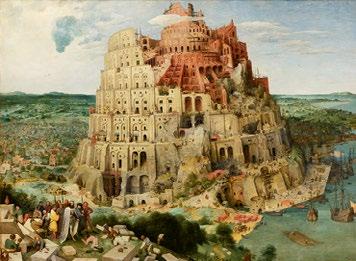
of Shinar shortly after the time of Noah and decided to build a city and a tower that reached the heavens. God was dismayed by their hubris, which had been stoked by the ease with which they were able to communicate. So God shattered their singular language into many and scattered the residents of Shinar around the globe.
In a 2022 article in The Atlantic, the social psychologist and author Jonathan Haidt used the story of Babel to explore the fragmentation, mutual incomprehension, and bubble-fication of American society. “Babel is a metaphor for what some forms of social media have done to nearly all of the groups and institutions most important to the country’s future—and to us as a people,” he wrote. Haidt’s article—which forms the basis of a book, Life After Babel, scheduled to be published by Penguin Press in 2025—traces how the Internet initially united us, creating the equivalent of a modern Tower of Babel, and then, seemingly irreparably, divided us.
In the late ’90s and the first decade of the new millennium, Haidt explains, social media was a force of connection and understanding (think: Myspace, Facebook, Google Translate, Google Maps). But as algorithms became the governing force of the Internet in the early 2010s, content that provoked engagement—which is to say, content that provoked strong reactions—was rewarded. Soon, outrage ruled the information superhighway.
By 2015, a year that Haidt describes as characterized by the “great awokening” on the left and the rise of Donald Trump on the right, we were no longer speaking the same language. Even if we were faced with identical facts (which, thanks to the vagaries of the algorithms being used, was rare), we would come to opposing conclusions. The tower had fallen. The result, Haidt argues, was a fracturing of trust in anyone outside our bubble and in our shared institutions, like the Supreme Court and local boards of elections.
Perhaps even more insidious, Haidt notes, has been the flattening of discourse inside our bubbles. He cites a study called “Hidden Tribes” by the pro-democracy group More in Common, which found that while Americans on the far right and far left comprised a minority of the surveyed population (6 percent and 8 percent, respectively), they were among the loudest and most prolific in sharing political content on social media. The authors of the study hypothesized that the uniformity of opinion expressed online was due in part to the fact that those who veered from the polarized party line often came under fire from the most engaged members of their own cohort.
Crow told me that she felt a flood of recognition when she read Haidt’s article. It keenly diagnosed the corrosive impact she feels social media has had on both democracy and society at large over the past decade. Although the original Bible story does not actually describe God toppling the Tower of Babel, the evocative image—of individuals running around hysterically as the world around them burns, gesticulating wildly but unable to communicate even the most basic concepts to one another—stuck with her. Her paintings in this show capture the tower in three phases: as it is being built, as it stands tall, and as it crumbles.
Crow has always been a student of history—political history, pop-cultural history, art-and-design history. Critics have described many of her large-scale, epic compositions as contemporary history paintings. But she does not depict history as it unfolded or even as we wish it had unfolded. Instead, she shows history as we might actually receive it today: distorted, manipulated, heightened, blurred, and out of context.

Crow’s first solo show in 2004, at New York’s Canada gallery, comprised sloppily rendered paintings of baroque interiors. In the following years, she shifted her focus to imaginary historical tableaux, with a focus on the late-nineteenth and early-twentieth centuries. There was Lincoln’s Funeral (2008), a darkened, disorienting composition of a funeral carriage and nineteenth-century hearse. There was The Bucket of Blood Saloon Destroyed by the 1906 San Francisco Earthquake (2008), and New York Stock Exchange After Bond Rally, 1919 (2008). Crow likes to capture the moments after a headline-making event. In her works, figures are scarce. What remains is the mess they left behind.
Only in the past five to ten years has Crow begun to explore current events in her work. Her style is a perfect fit for our sometimes surreal, often fractured political times, and it hits especially hard during an election year. Her technical process reflects the kind of din and disjunction at the heart of the Babel story, but it contains within it a commitment to popping her own bubble. She starts by creating lists of outlandish scenes and scenarios (see: monster truck rally sponsored by BetterHelp). Then she builds collages of these imagined scenes, by hand and with Photoshop, from her broad archive of images. Her archive includes antique postcards, her own photographs, and the results of online research. After printing the collages, she photo-transfers portions

onto the surface of the canvas; covers it in oil paint; and adds sprays, drips, and swipes of color on top.
This process contains within it multiple opportunities for images to obscure one another and be manipulated. The composition ping-pongs back and forth between the real world and the digital realm, taking on a slightly new cast at each turn—like when we recount to a friend over dinner a tweet we read about a stranger’s conversation with their mother.
For her latest series, Crow experimented a bit with AI image generators, asking them to enlarge an image, change a color, or render a particularly outlandish scenario. Sometimes, the tool added welcome confusion. But more often, AI didn’t get it right and contributed little to the final product. Nevertheless, the specter of its presence in her work speaks to yet another element of contemporary life that defines our post-Babel existence: With AI in the mix, we have become ever more skeptical that what we are seeing or watching is real.
In his Atlantic essay, Haidt characterizes the post-Babel age as one in which “stories cannot be shared (or at least trusted) across more than a few adjacent fragments.”
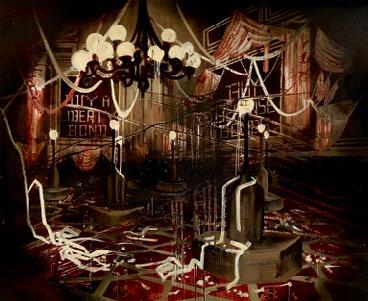
Crow’s process makes tangible and literal our tendency to receive information in fragments and reassemble those fragments to suit whatever narrative we wish to put forward. But Crow is not looking to fool anyone. By creating unlikely juxtapositions— like distorted American flags framing a cluster of cactuses—and using hues of bright pink, acid yellow, and lime green, she puts the artificial, constructed nature of her images at the forefront. Then, she adds another layer of complexity on top. Her drips and visible brushstrokes remind the viewer—in a way we often forget or doubt when interacting online—that there is actually a real person behind what we are seeing.
It is perhaps unsurprising that Crow would become the artist of our post-Babel age. She grew up in Dallas, a city that is politically heterogeneous. Her brother is a truck driver in Detroit. As a child, she regularly went on road trips across the country with her family, which gave her an up-close view of the wide range of landscapes and communities that make up America. She has continued the tradition as an adult: Last summer, she drove from Los Angeles to New York. I suspect she would score very well on the “Do You Live in a Bubble?” quiz.
Crow created her new body of work with a large-scale industrial printer. While many of her earlier paintings bore a tile pattern, reflecting the limited size of each photo
transfer, the new ones take on the images in full, with fewer gridlines. The result is an even more intense sense of overwhelm; it feels as if these paintings—of an exploding party-supply store, a bursting fruit stand, and a thick tropical forest—are shouting at you and threatening to swallow you up.
As a viewer, you have choices. You can avert your eyes. You can loosen your gaze and let the whole picture go blurry. Or you can commit to looking more closely, zooming in on a drip here, an overlap of images there. In the Babel story, God ensures that we are no longer able to communicate easily or trust what we hear. But Crow’s work offers a path to a different ending. If we slow down, look and listen carefully, and resolve to sit in our discomfort, Crow seems to suggest, we might eventually be able to engage meaningfully with one another again.

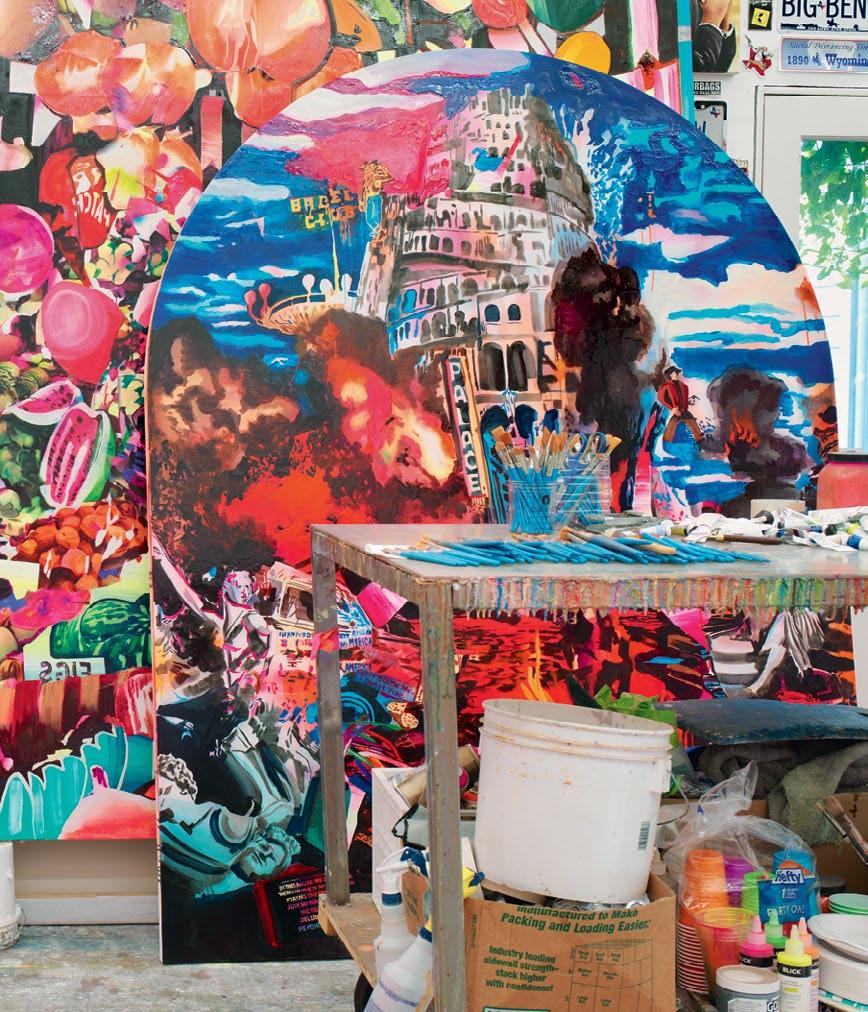


Acrylic, spray paint, photo transfer, and oil on canvas
84 x 66 inches
213.4 x 167.6 cm
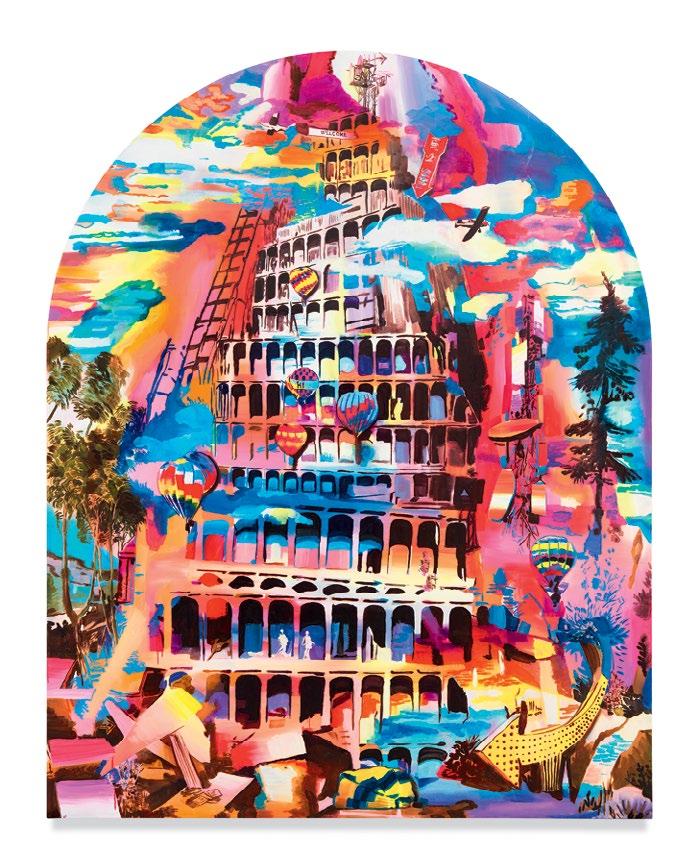
Fragility (Pax Americana), 2023
Acrylic, spray paint, photo transfer, and oil on canvas
67 x 67 inches
170.2 x 170.2 cm
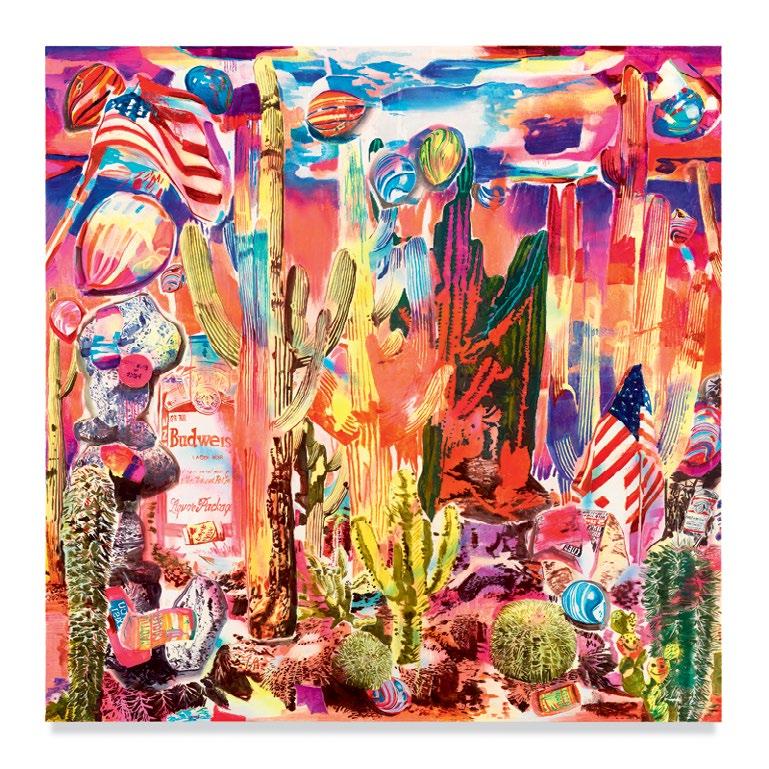
Market Volatility, 2023
84 x 72 inches
213.4 x 182.9 cm
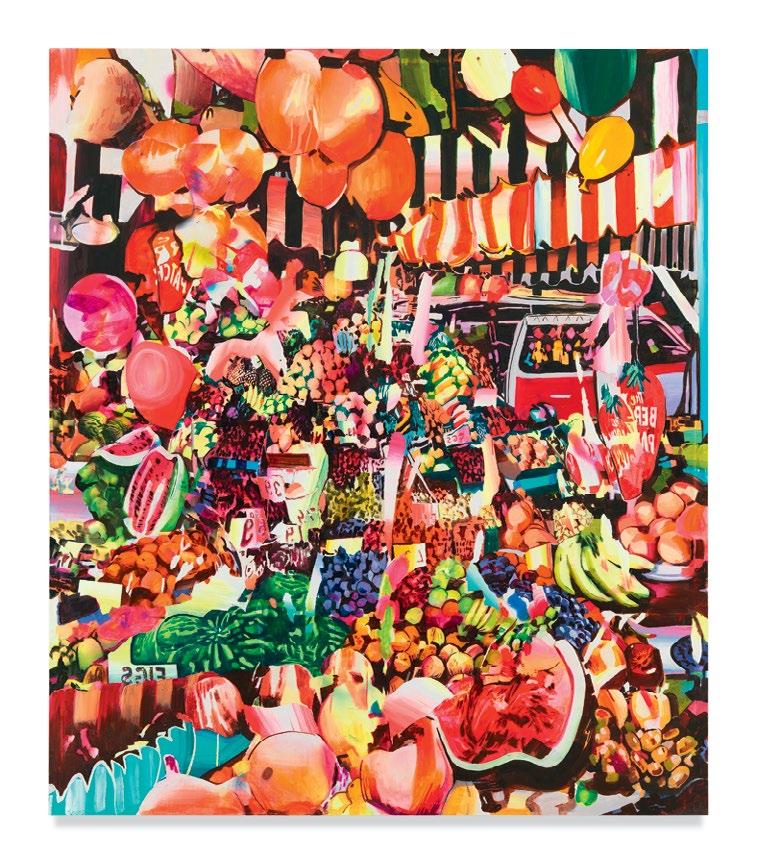
Acrylic, spray paint, photo transfer, and oil on canvas
71 1/2 x 63 inches
181.6 x 160 cm
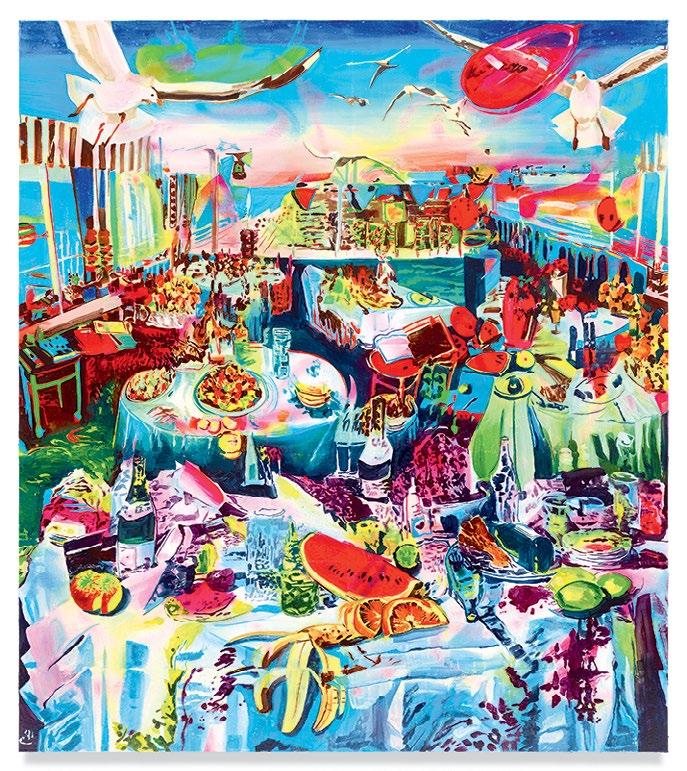
Tower of Babel, 2024
Acrylic, spray paint, photo transfer, and oil on canvas
90 x 110 inches
228.6 x 279.4 cm
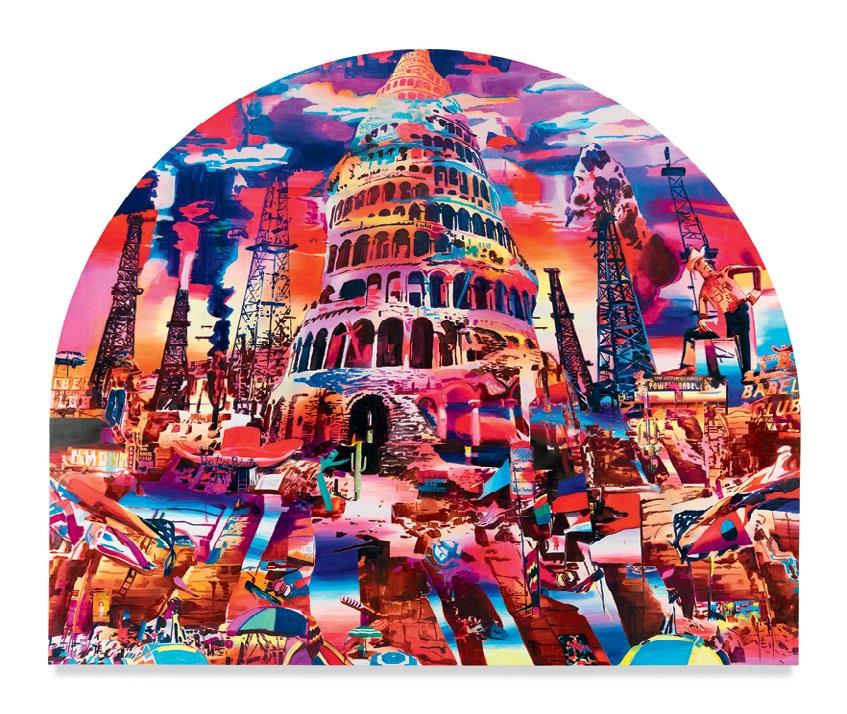
84 x 70 inches
213.4 x 177.8 cm
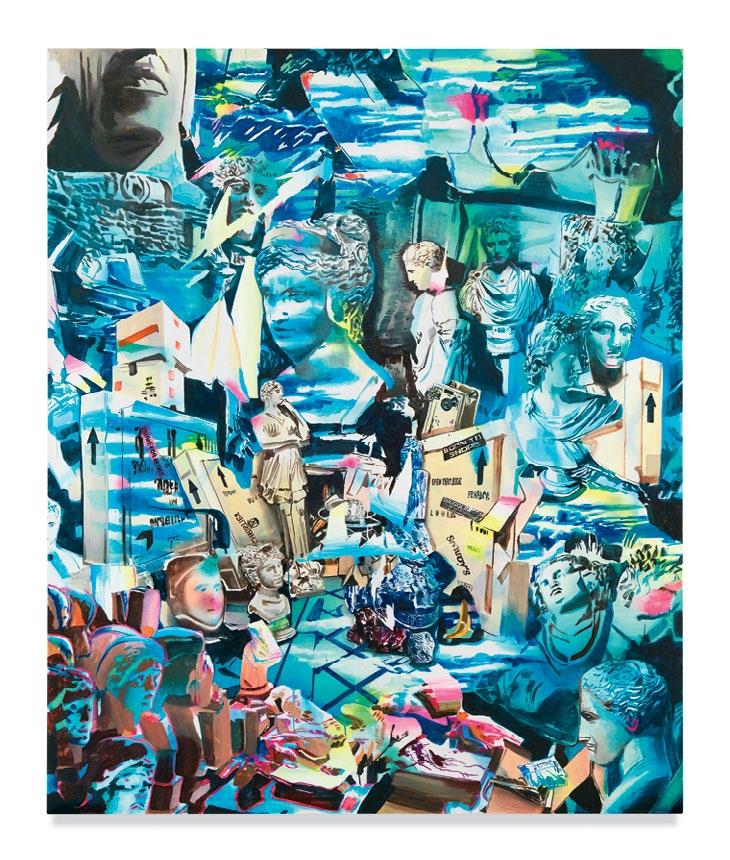
Monster Jam Sponsored By BetterHelp.com, 2024
Acrylic, spray paint, photo transfer, and oil on canvas
78 x 96 inches
198.1 x 243.8 cm

Party Supply Explosion, 2024
Acrylic, spray paint, photo transfer, and oil on canvas
70 x 84 inches
177.8 x 213.4 cm
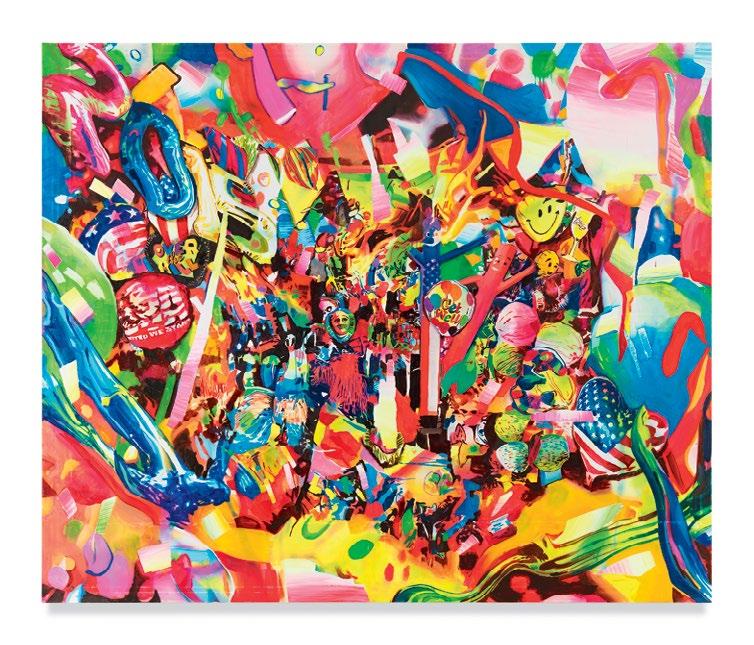
Acrylic, spray paint, photo transfer, and oil on canvas
60 x 48 inches
152.4 x 121.9 cm
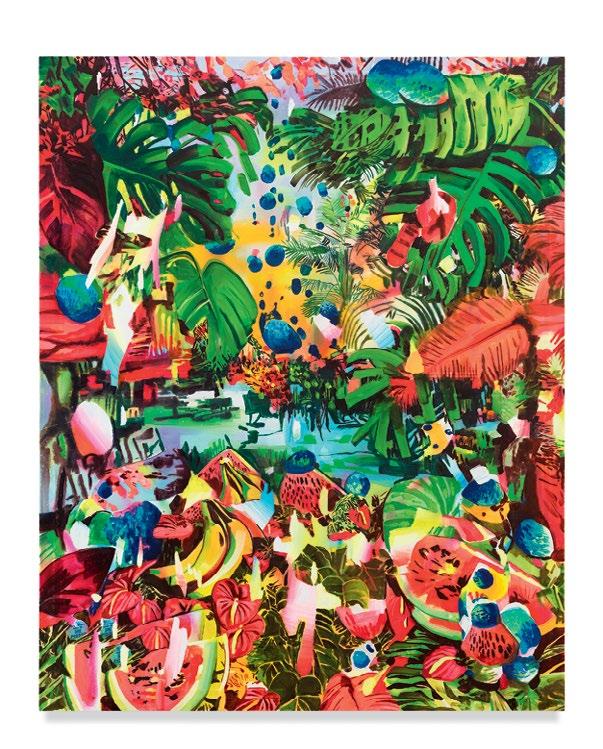
Acrylic, spray paint, photo transfer, and oil on canvas
84 x 66 inches
213.4 x 167.6 cm
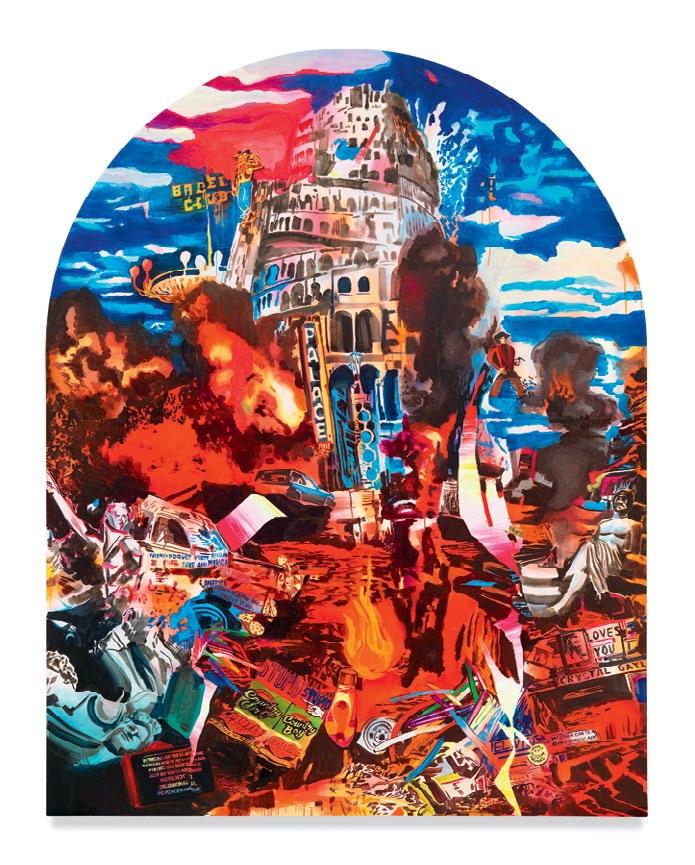
Confusion of Tongues, 2024
Acrylic, spray paint, photo transfer, and oil on canvas
84 x 70 inches
213.4 x 177.8 cm

Acrylic, spray paint, photo transfer, and oil on canvas
60 x 48 inches
152.4 x 121.9 cm

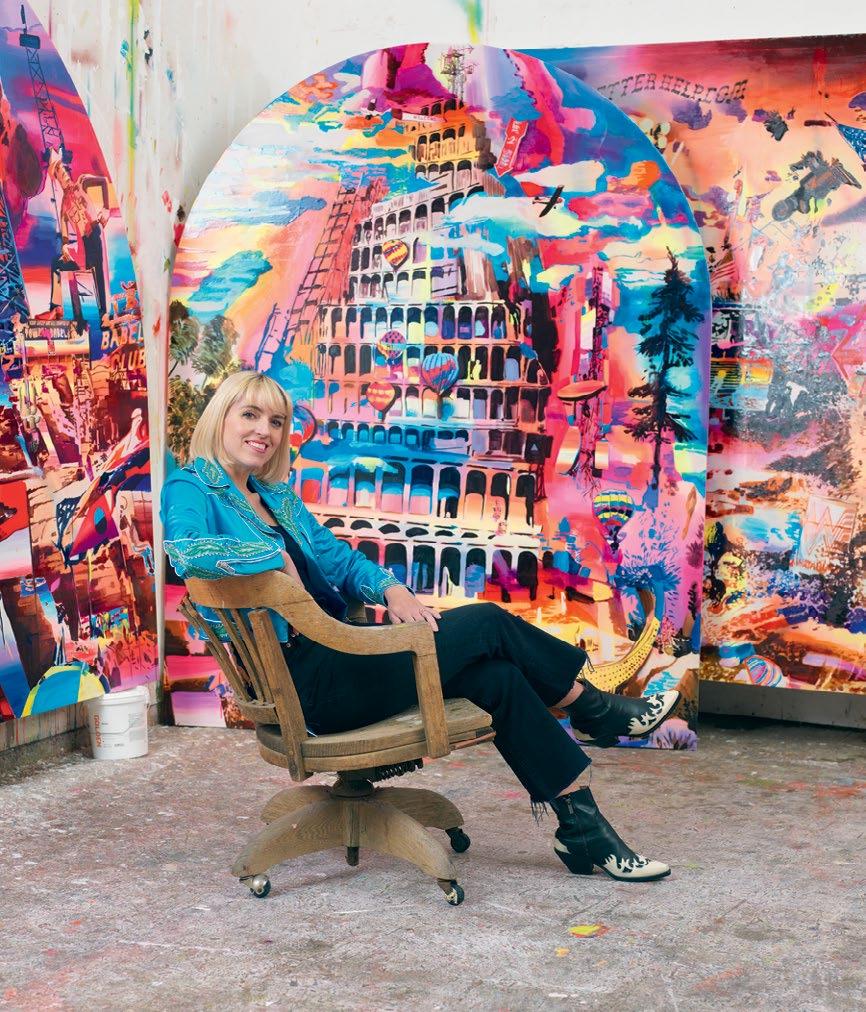
Born in Dallas, TX in 1982
Lives and works in Los Angeles, CA
EDUCATION
2006
MFA, Yale University, New Haven, CT
2004
BFA, School of Visual Arts, New York, NY
2024
“Babel,” Miles McEnery Gallery, New York, NY
2022
“Heartbreak Hotel,” Over the Influence, Los Angeles, CA
2021
“Men to Match My Mountains,” Honor Fraser, Aspen, CO
2020
“Next year at Marienbad,” Galerie Nathalie Obadia, Paris, France
“Smoke and Mirrors,” Over the Influence, Hong Kong
2019
“Trust Fall,” The Hole, New York, NY
2018
“Westification,” Museum of Contemporary Art Tucson, Tucson, AZ
2017
“The Happiest People on Earth,” Honor Fraser, Los Angeles, CA
2015
“Madame Psychosis Holds a Séance,” Honor Fraser, Los Angeles, CA
“HYSTERIA: Spatial Conversations with Florine Stettheimer,” Sargent’s Daughters, New York, NY
2014
“Rosson Crow,” Musée régional d’Art contemporain, Sérignan, France
“Art District,” Le Royal Monceau, Paris, France
2013
“Reconstruction,” Galerie Nathalie Obadia, Paris, France
2012
“Ballyhoo Hullabaloo Haboob,” Honor Fraser, Los Angeles, CA
2010
“Myth of the American Motorcycle,” Contemporary Arts Center, Cincinnati, OH
“Bowery Boys,” Deitch Projects, New York, NY
2009
“Paris, Texas,” Galerie Nathalie Obadia, Paris, France
“FOCUS: Rosson Crow,” Modern Art Museum of Fort Worth, Fort Worth, TX
“Texas Crude,” White Cube, London, United Kingdom
2008
“Night at the Palomino,” Honor Fraser, Los Angeles, CA
2006
“Hotel and Lounge,” Canada Gallery, New York, NY
2005
“With Love, from Texas,” Galerie Nathalie Obadia, Paris, France
2004
“Estate Between,” Canada Gallery, New York, NY
2023
“Moving Mountains,” The Pit, Palm Springs, CA
“Storage Wars,” The Hole, Los Angeles, CA
“Baker’s Dozen,” Torrance Art Museum, Torrance, CA
“15 Year Anniversary Brussels,” Galerie Nathalie Obadia, Brussels, Belgium
2022
“It Takes a Village,” Library Street Collective, Detroit, MI
“Manscaping,” The Hole, Los Angeles, CA
“Texan: Part I,” Various Small Fires, Dallas, TX
“Christen Sveaas Art Foundation: The Travel Bureau” (selected by Paulina Olowska), Whitechapel Gallery, London, United Kingdom
2021
“Inauguration,” Galerie Nathalie Obadia, Paris, France
“Un goût de vacances,” Centre d’Art
Contemporain, Meymac, France
“High Emission Zone,” Galerie Nathalie Obadia, Paris, France
“Nature Morte,” The Hole, New York, NY
2020
“Mirror-Gazing,” The Pit, Los Angeles, CA
2019
“The Thousand and One Nights,” Artual Gallery, Beirut, Lebanon
2018
“Xeriscape,” Library Street Collective, Detroit, MI
2017
“Man Alive,” Maruani Mercier, Brussels, Belgium
2016
“Highlights from the Permanent Collection,” screening of “Madame Psychosis Holds a Séance,” Modern Art Museum of Fort Worth, Fort Worth, TX
“Fresh Cuts,” Eric Firestone Gallery, East Hampton, NY
“The Neon Wilderness: Voices from Los Angeles,” The Conversation, Berlin, Germany
2015
“All Killer No Filler,” Eric Firestone Gallery, East Hampton, NY
2014
“Go With the Flow,” The Hole, New York, NY
“Positivilly Marvillainous,” Eric Firestone Gallery, East Hampton, NY
“Ephemera as Evidence,” Visual AIDS, New York, NY
“Domestic Unrest,” Pippy Houldsworth Gallery, London, United Kingdom
2013
“And those who were seen dancing were thought to be insane by those who could not hear the music,” Friedman Benda, New York, NY
“Chicken or Beef?,” The Hole, New York, NY
2012
“In Between,” Galerie Nathalie Obadia, Brussels, Belgium
2011
“NY: New Perspectives,” Brand New Gallery, Milan, Italy
“Contemporary Magic: A Tarot Deck Art Project,” The Andy Warhol Museum, Pittsburgh, PA
“Uncovered” (presented by New York Academy of Art and Eileen Guggenheim), Eden Rock Gallery, St. Barths, French West Indies
2010
“Invited Room, the Royal Academy Summer Exhibition 2010,” Royal Academy of the Arts, London, United Kingdom
“Le Meilleur des Mondes,” Musée d’Art Moderne Grand-Duc Jean, Luxembourg City, Luxembourg
2009
“New York Minute,” MACRO Future, Museum of Contemporary Art of Rome, Rome, Italy
“Stages” (organized by Lance Armstrong and Nike), Perrotin, Paris, France
“Bitch Is The New Black,” Honor Fraser, Los Angeles, CA
2008
“Out of Storage I – Chosen Paintings from the Collection,” Musée d’Art Moderne Grand-Duc Jean, Luxembourg City, Luxembourg
“Subtraction,” Deitch Projects, New York, NY
2007
“Accidental Painting,” Perry Rubenstein Gallery, New York, NY
“Distinctive Messengers,” House of Campari, New York, NY
“Cabinet of Curiosities,” The Journal Gallery, New York, NY
2006
“The Garden Party,” Deitch Projects, New York, NY
2005
“Little Odysseys,” Marianne Boesky Gallery, New York, NY
“The Third Peak,” Galerie Art: Concept, Paris, France
2004
“Yearning for Yours,” School of Visual Arts Gallery, New York, NY
“Familiar Haunts,” The Happy Lion, Los Angeles, CA
“Majority Whip,” White Box, New York, NY
“Poets of Miniature,” OfficeOps, Brooklyn, NY
“Mira, Mira, Look, Look,” Visual Arts Gallery, New York, NY
2003
“Kult 48 Klubhouse,” Deitch Projects, Brooklyn, NY
RESIDENCIES
2006
Cité internationale des Arts, Paris, France
SELECT COLLECTIONS
Carré d’Art – Musée d’art contemporain de Nîmes, Nîmes, France
Christen Sveaas Art Foundation, Jevnaker, Norway
LVMH Moët Hennessy Louis Vuitton, Paris, France
Modern Art Museum of Fort Worth, Fort Worth, TX
Musée d’Art Moderne Grand Duc-Jean, Luxembourg City, Luxembourg
Zabludowicz Collection, London, United Kingdom
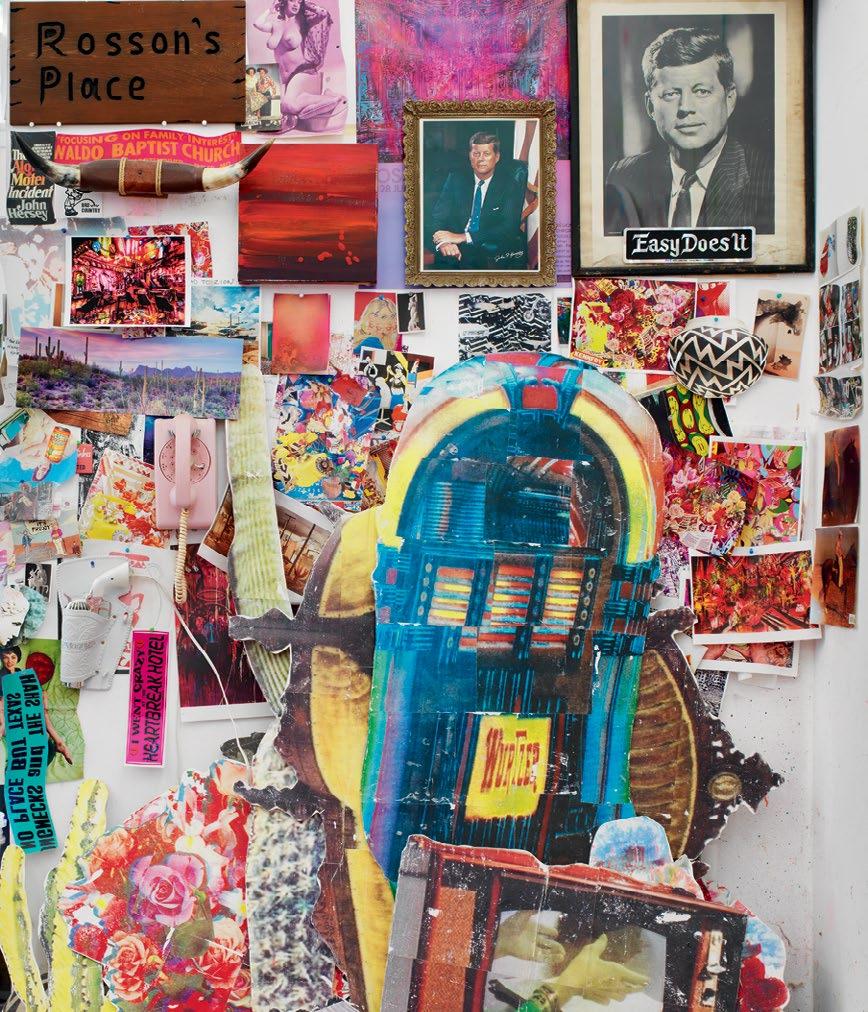
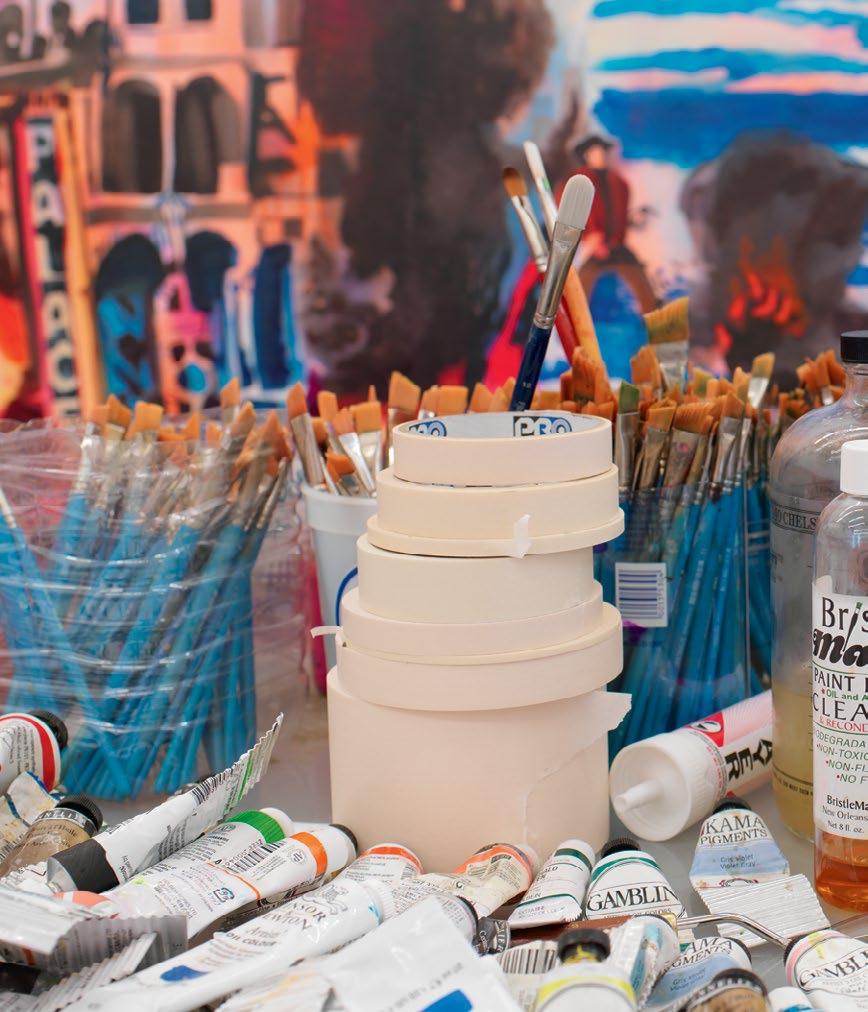
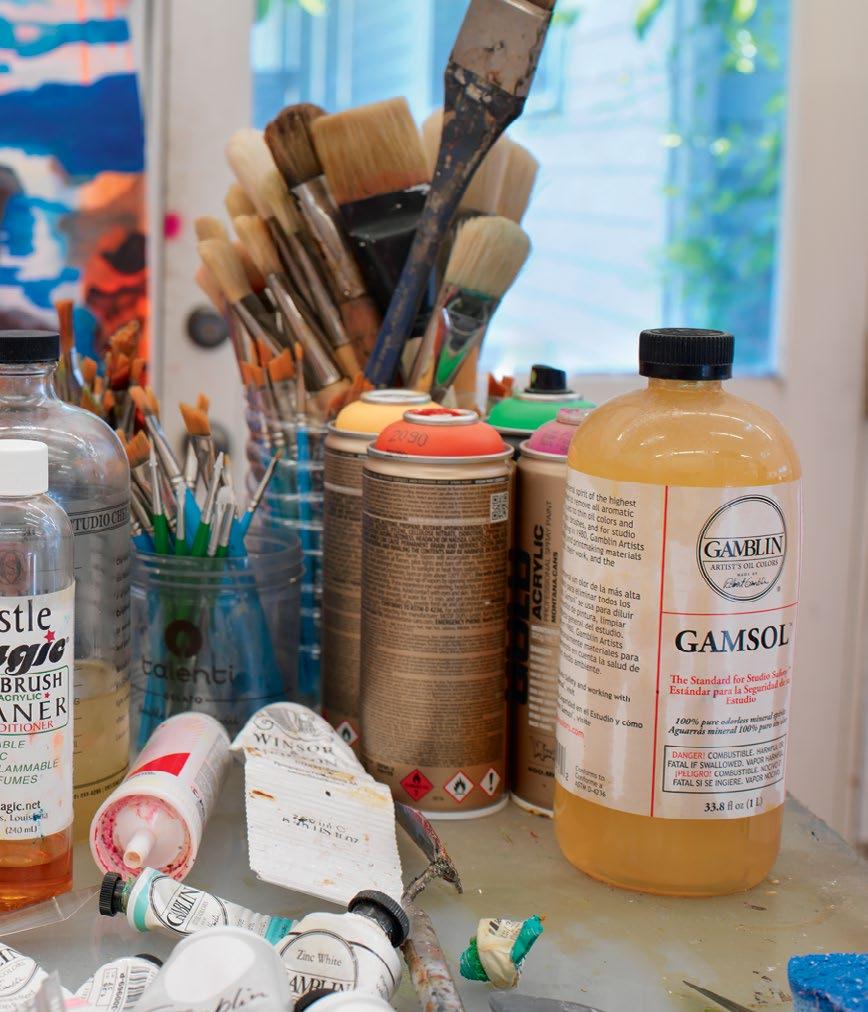
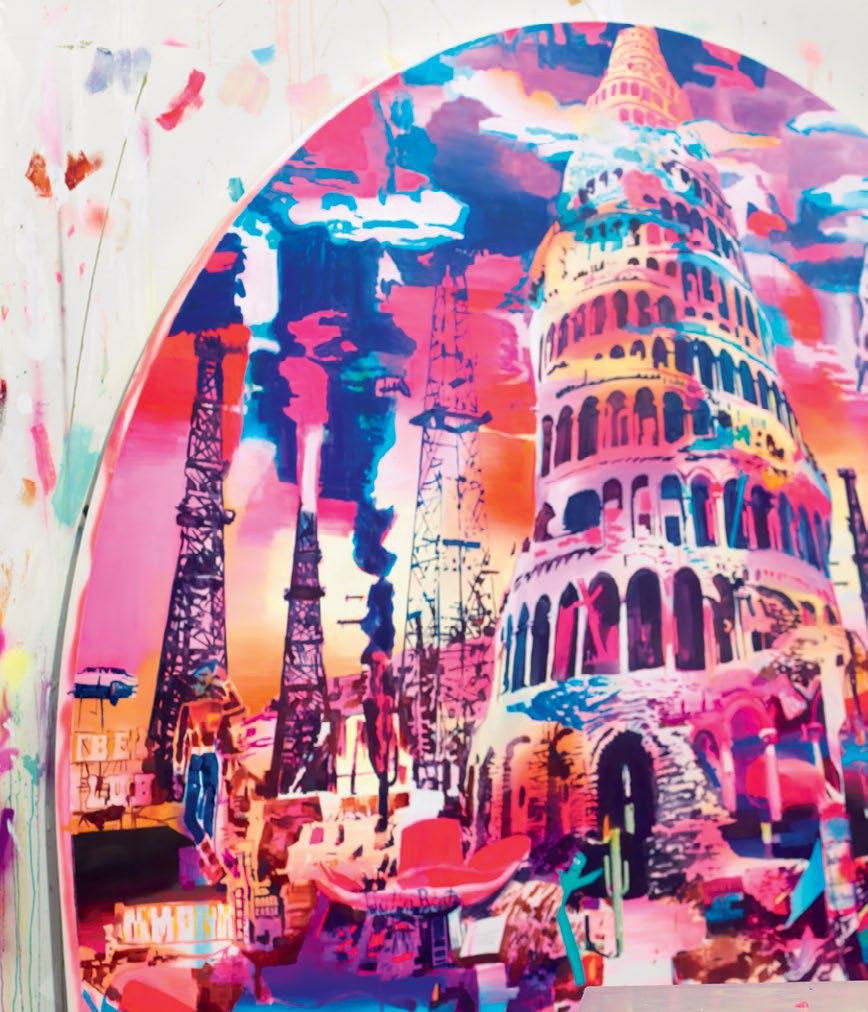
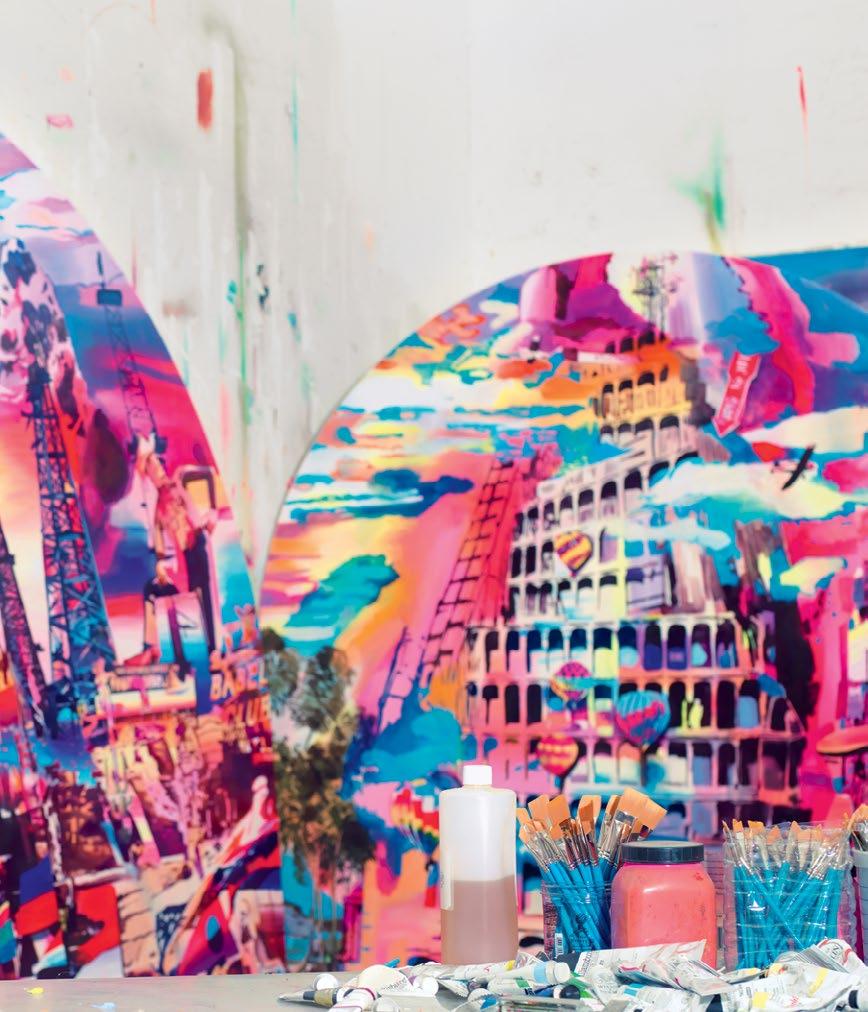
Published on the occasion of the exhibition
16 May – 3 July 2024
Miles McEnery Gallery
511 West 22nd Street New York NY 10011
tel +1 212 445 0051 www.milesmcenery.com
Publication © 2024 Miles McEnery Gallery
All rights reserved
Essay ©2024 Julia Halperin
Publications and Archival Associate Julia Schlank, New York, NY
Photo credits: p. 4: © Artchive p. 6, 7, 8: © The artist, Los Angeles, CA
Photography by Christopher Burke Studio, Los Angeles, CA
Color separations by Echelon, Los Angeles, CA
Catalogue layout by McCall Associates, New York, NY
ISBN: 979-8-3507-2957-3
Cover: Building of Babel, (detail), 2024 Endsheets: Rosson Crow’s Studio Wall, Los Angeles, CA



